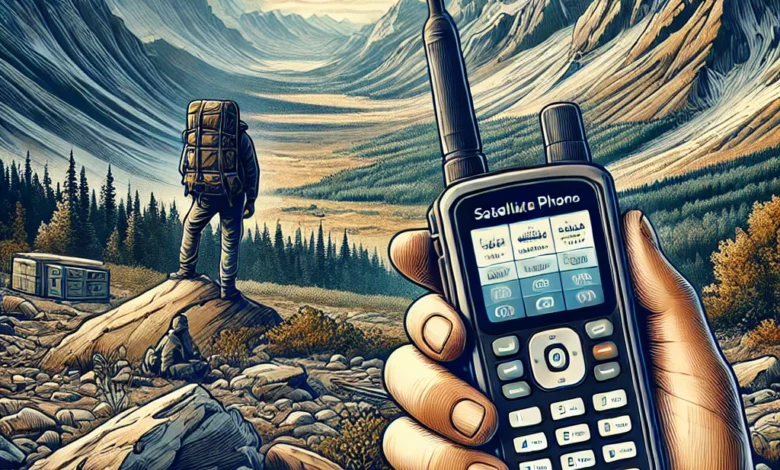Your Lifeline in Remote Areas: Satellite Phones Explained

Introduction to Satellite Phones
Communication is vital no matter where you are. Whether you’re exploring the far reaches of the wilderness, scaling remote mountain peaks, or conducting research in isolated regions, staying connected can be a matter of safety and survival. Enter satellite phones—a lifeline that ensures you’re never out of touch, no matter how far off the grid you go.
Satellite phones, often referred to as “satphones,” are the pinnacle of reliable communication when traditional mobile networks fail. They serve as a bridge between the remotest corners of the Earth and the rest of the world, connecting people with voice calls, messaging, and sometimes even internet access. But what makes satellite phones so essential in these areas? Let’s dive into why they’ve become the go-to technology for adventurers, explorers, researchers, and rescue workers alike.
The Significance of Satellite Phones in Remote Areas
The world is vast, with vast swathes of land where cell phone coverage is spotty, if not entirely non-existent. Traditional mobile networks rely on terrestrial towers that offer coverage limited by distance, geographical obstacles, and the density of infrastructure. As you venture further into remote or extreme environments—whether it’s the Arctic tundra, deep forests, deserts, or open seas—this coverage disappears, leaving you without a reliable communication channel.
This is where satellite phones shine. Instead of relying on land-based towers, satellite phones communicate directly with satellites orbiting the Earth, ensuring coverage over even the most isolated regions. These phones allow users to make calls, send text messages, and access limited data services from virtually anywhere on the planet, making them essential for those venturing beyond the bounds of civilization.
Visit https://www.outdoortechlab.com/satellite-phones-mobile/
How Satellite Phones Work: A Closer Look
Satellite phones may look like traditional cell phones, but their technology operates on an entirely different system. Unlike cellular phones, which connect to the nearest land-based tower, satellite phones beam signals directly to satellites in space.
There are two primary types of satellites that facilitate this communication: geostationary satellites and low-earth orbit (LEO) satellites. Geostationary satellites orbit at a fixed point above the Earth, covering large areas, while LEO satellites orbit closer and move around the Earth, providing global coverage through a network of interconnected satellites.
When you make a call on a satellite phone, the signal travels from your device to the satellite in orbit, which then routes it to the nearest available ground station. From there, the call is connected to the public telephone network, allowing you to reach anyone, anywhere. This technology ensures that satellite phones work in areas where no terrestrial infrastructure exists.
Watch the following video :
Key Features of Satellite Phones
Satellite phones are designed for reliability in extreme environments, and they come equipped with features that ensure their effectiveness in the field.
- Voice and Data Communication: While satellite phones are primarily used for voice calls, many modern models also support text messaging and data services. However, data speeds are significantly slower compared to traditional internet connections.
- Durability: Satellite phones are built to withstand harsh conditions. Most models are rugged, shock-resistant, and come with weatherproofing, making them ideal for use in rough terrains, extreme weather, or maritime environments.
- Battery Life: Long-lasting battery life is crucial for users in remote areas. Satellite phones are designed to last for days or even weeks on standby, ensuring that you’re not left without communication when you need it most.
- Global Coverage: The most significant advantage of satellite phones is their near-global coverage, meaning you can stay connected almost anywhere on Earth.
The Role of Satellite Phones in Emergency Situations
Satellite phones have become indispensable tools in emergency and rescue operations. In crisis situations—whether it’s a natural disaster, a medical emergency in a remote location, or a lost hiker—having a satellite phone can be the difference between life and death. These phones allow users to contact emergency services or rescue teams, providing vital location information that can expedite help.
In disaster scenarios where landlines and cell towers may be damaged or overloaded, satellite phones often remain the only functioning communication tool, ensuring that aid organizations and first responders can coordinate rescue efforts effectively.
Why Traditional Mobile Networks Fail in Remote Locations
Traditional mobile networks are built on a system of towers that transmit signals to and from phones. This network is dependent on infrastructure, which makes it reliable in urban and suburban areas but less effective in remote regions where the installation of towers is unfeasible. Mountains, forests, oceans, and deserts are notorious for blocking or degrading signals, leaving travelers cut off from the grid.
Moreover, natural disasters like earthquakes, floods, or hurricanes can damage mobile networks, rendering them useless when they’re needed most. Satellite phones, on the other hand, bypass the need for terrestrial infrastructure, ensuring continuous service regardless of what’s happening on the ground.
Who Needs a Satellite Phone?
Not everyone needs a satellite phone, but for certain professions and lifestyles, they’re invaluable.
- Adventurers and Explorers: Whether you’re trekking through remote wilderness or embarking on a solo expedition to a distant corner of the globe, a satellite phone ensures you stay connected no matter how far you wander.
- Remote Workers and Researchers: Those working in off-grid locations—scientists conducting research in isolated areas, engineers building infrastructure in remote places—rely on satellite phones for daily communication.
- Disaster Response Teams: Emergency responders, firefighters, and rescue teams often depend on satellite phones during disasters where traditional networks have collapsed.
- Global Travelers: For people who frequently travel to remote regions or countries with limited infrastructure, having a satellite phone provides peace of mind.
Satellite Phone Versus Cell Phones: The Key Differences
When comparing satellite phones with cell phones, the most notable difference is their range of connectivity. Cell phones are perfect for urban and suburban use, but they are tethered to a network of towers that limit their coverage to areas with sufficient infrastructure. Satellite phones, however, are untethered from this system, giving them the ability to work in regions where no traditional signal can reach.
However, there are trade-offs. Satellite phones are generally bulkier, more expensive, and have limited internet capabilities compared to smartphones. But in terms of reliability and coverage, especially in extreme environments, they are unparalleled.
Satellite Phones for Maritime and Aviation Use
Satellite phones are not just limited to land use. For those navigating open waters or flying over remote regions, having a satellite phone onboard can be a crucial safety measure.
In maritime environments, where ships often travel far from land-based communication networks, satellite phones allow for constant contact with shore-based operations. They’re especially important for smaller vessels without built-in communication systems. In aviation, satellite phones are used as a backup communication method when flying over remote areas like the polar regions, deserts, or vast ocean expanses.
Satellite Phones in Extreme Weather and Environmental Conditions
One of the standout features of satellite phones is their ability to function in extreme conditions. These devices are built to handle temperatures ranging from freezing cold to scorching heat, ensuring that they remain operational no matter where you find yourself. Whether you’re in a snowstorm in the Arctic or a sweltering desert, satellite phones continue to provide reliable service.
Additionally, many models come with waterproofing and dustproofing, making them ideal for use in harsh, unpredictable environments like rainforests or deserts.
How to Choose the Right Satellite Phone for Your Needs
When selecting a satellite phone, it’s essential to consider your specific needs and the environments you’ll be using it in. Some key factors to think about include:
- Coverage Zones: Ensure the satellite network provides coverage in the regions you plan to travel to.
- Durability: If you’re heading into extreme environments, opt for a rugged, durable model.
- Battery Life: Consider how long you’ll be in the field and whether you’ll have access to power for recharging.
- Features: Depending on your needs, you may want a phone with additional features like GPS tracking, messaging services, or internet access.
Tips for Using Satellite Phones Efficiently
To get the most out of your satellite phone, follow these tips:
- Extend Battery Life: Turn off the phone when it’s not in use and keep it in a warm location to preserve battery life in cold environments.
- Optimize Signal: Make sure you have a clear line of sight to the sky when using your satellite phone. Mountains, buildings, or dense foliage can obstruct the signal.
- Manage Costs: Satellite phone services can be expensive, so keep an eye on your usage and opt for prepaid plans if possible.
The Evolution of Satellite Phones: Past, Present, and Future
Satellite phones have come a long way since their inception. Early models were large, cumbersome, and expensive, making them inaccessible to the average person. Over time, advancements in satellite technology and manufacturing have made these phones smaller, more affordable, and more powerful.
As satellite technology continues to evolve, we can expect future satellite phones to become even more reliable, with faster data speeds and improved global coverage. Additionally, innovations in satellite networks will likely reduce the cost of using these devices, making them more accessible to everyday users.
Environmental and Ethical Considerations of Satellite Technology
While satellite phones offer many benefits, it’s important to consider the environmental impact of satellite technology. The launch of satellites into orbit requires significant energy, and the growing number of satellites raises concerns about space debris and sustainability. Efforts are being made to develop more eco-friendly satellite technologies, but this remains an ongoing challenge.
Conclusion
Satellite phones are a critical lifeline for anyone venturing into remote or extreme environments. Whether you’re an adventurer exploring uncharted territories, a researcher working in isolated regions, or a responder in disaster-stricken areas, satellite phones ensure that you remain connected when traditional communication networks fail.
As technology advances, satellite phones will only continue to improve, offering faster, more reliable communication in even the most challenging environments. In a world where staying connected can make all the difference, satellite phones are the ultimate tool for those who need reliable communication in remote areas.
FAQs
- Are satellite phones expensive to use? Yes, satellite phones tend to be more expensive than regular mobile phones, both in terms of the device itself and the cost of services. However, they provide unparalleled coverage in remote areas where regular phones don’t work.
- Can I use a satellite phone anywhere in the world? Most satellite phones offer global coverage, but it’s important to check the specific network you’re using to ensure it covers the region you plan to visit.
- How long does the battery last on a satellite phone? Satellite phones are designed for extended use, with standby times often lasting several days to weeks. Battery life during calls typically ranges from 4 to 10 hours, depending on the model.
- Do satellite phones work indoors? Satellite phones require a clear line of sight to the sky to function properly, so they may not work well indoors, in dense forests, or in deep valleys. External antennas can improve connectivity in these situations.
- Can I send text messages from a satellite phone? Yes, many modern satellite phones support SMS text messaging, although messaging services may be more expensive than on traditional networks.



